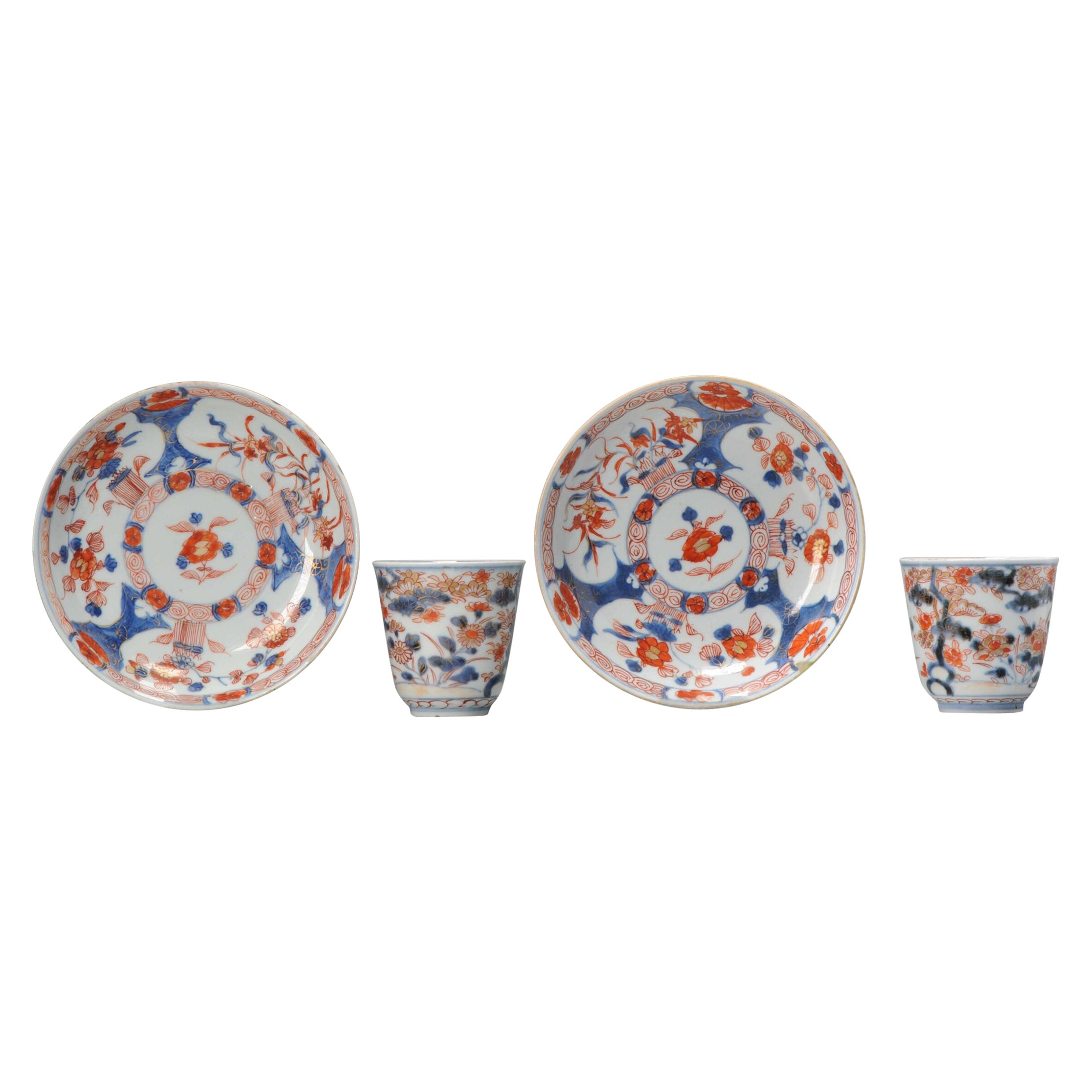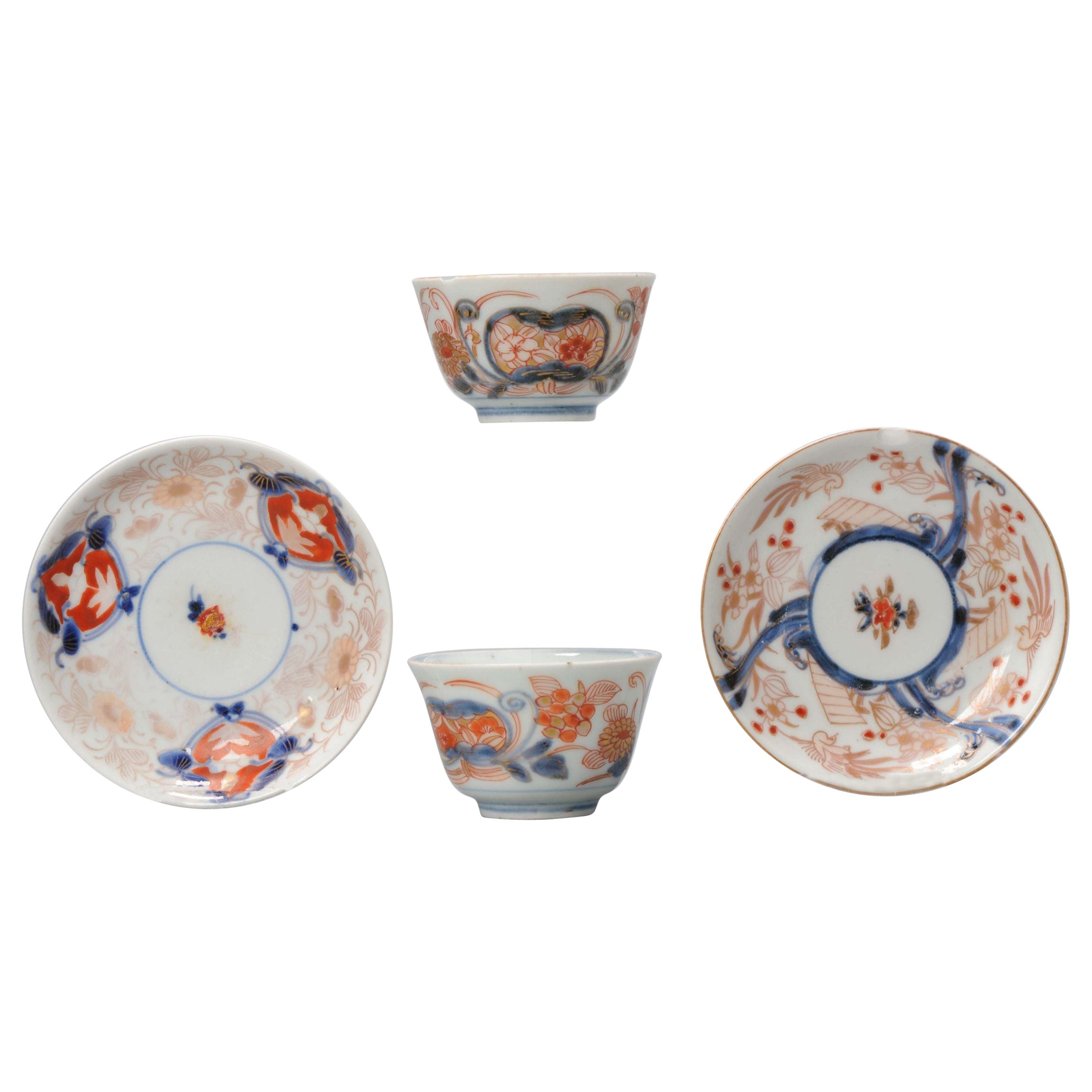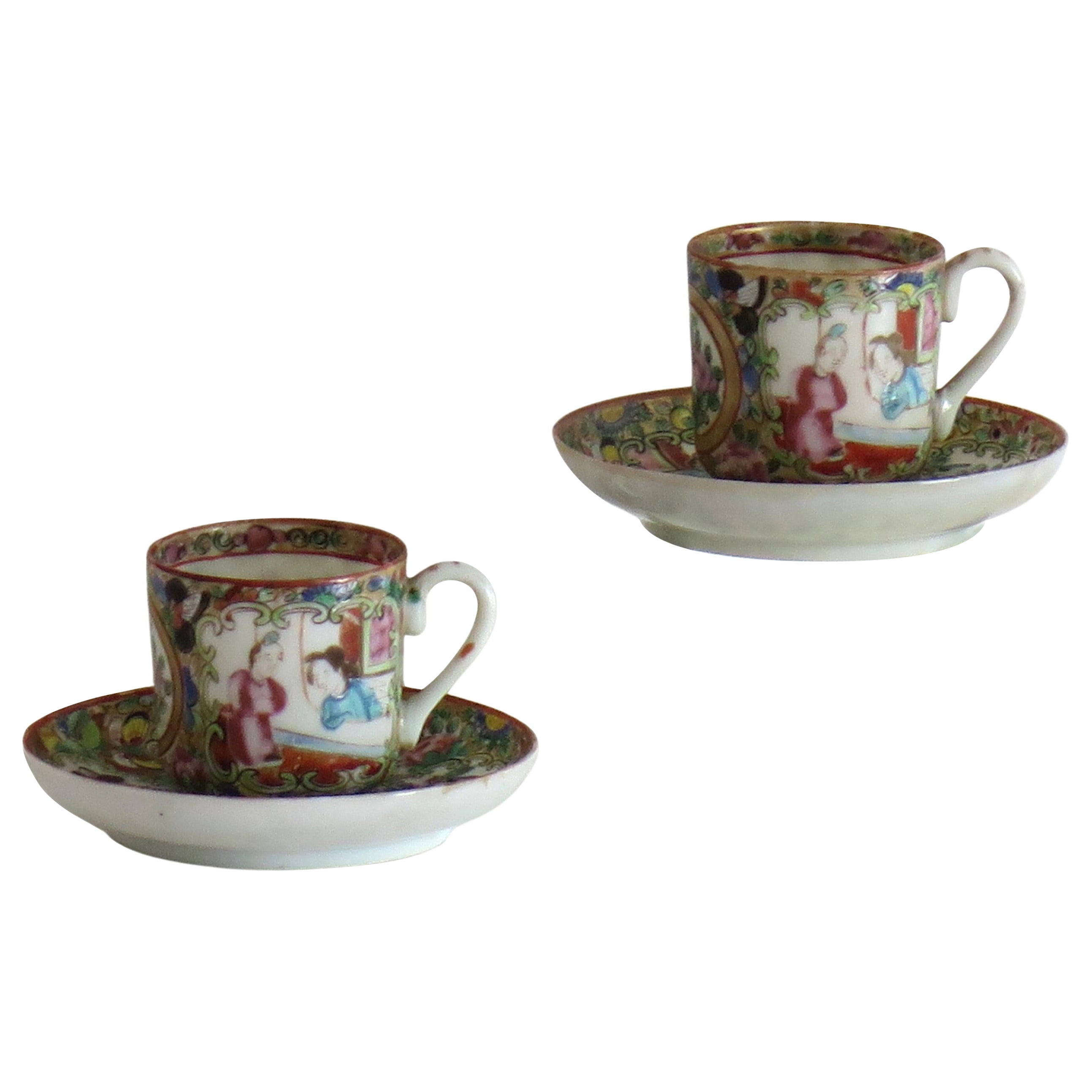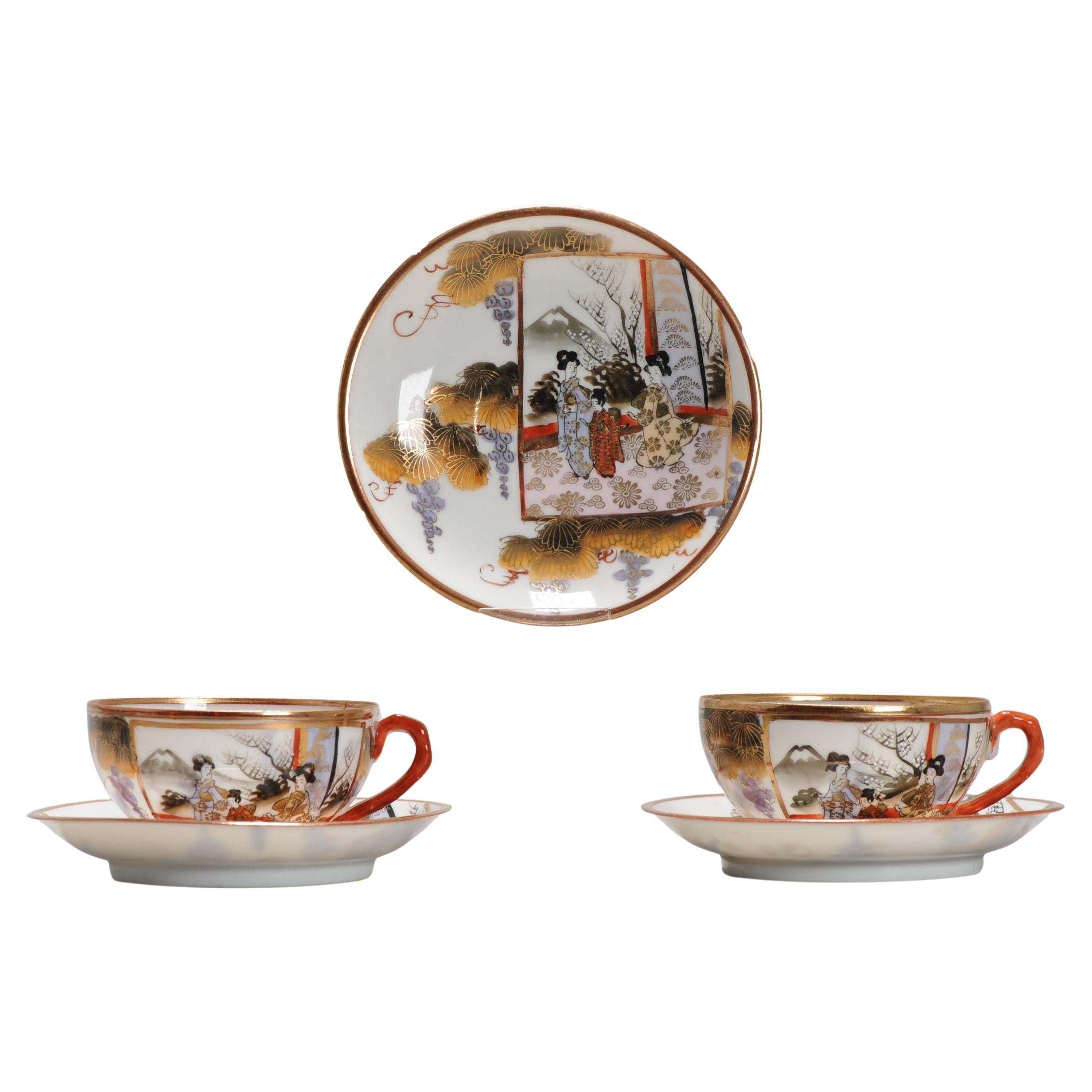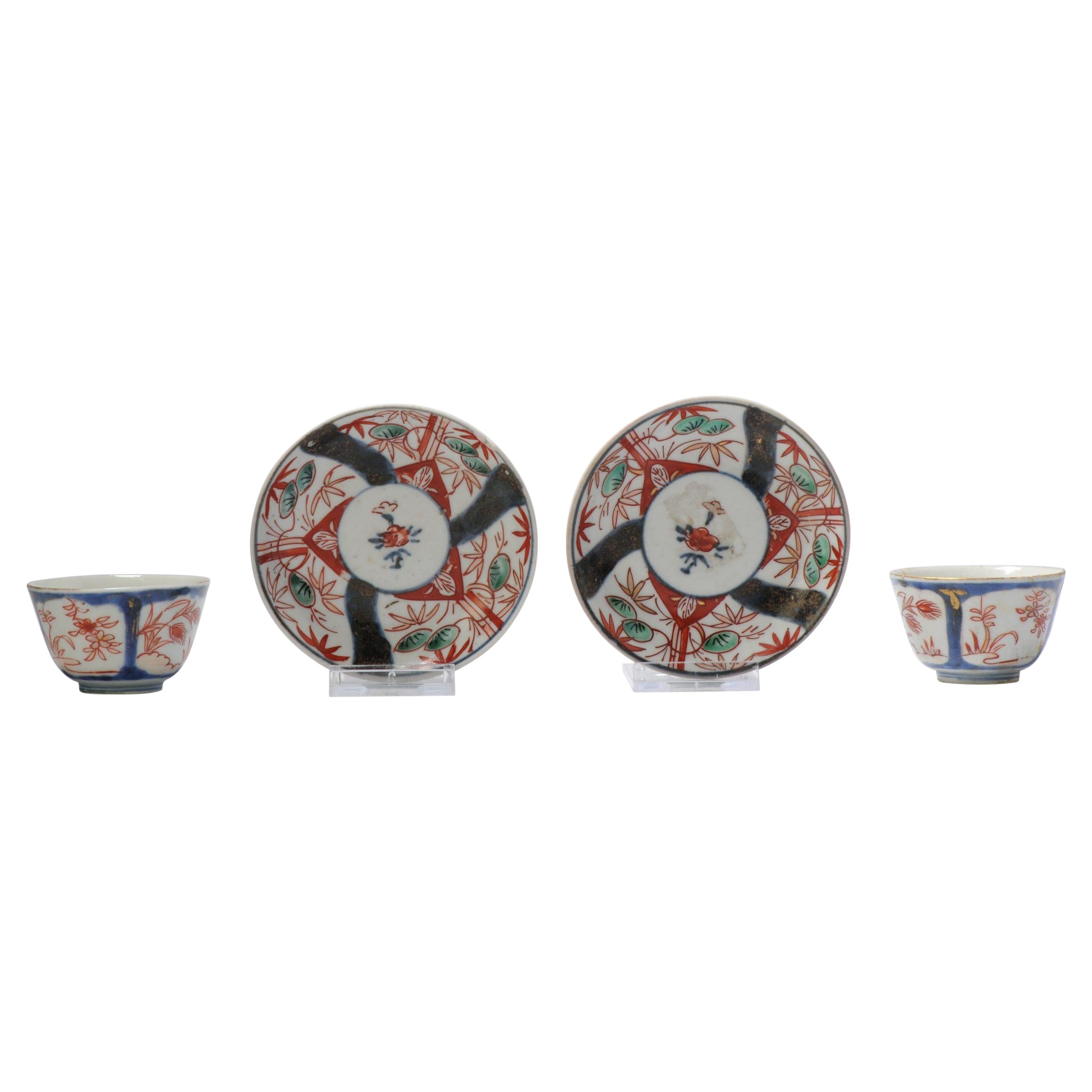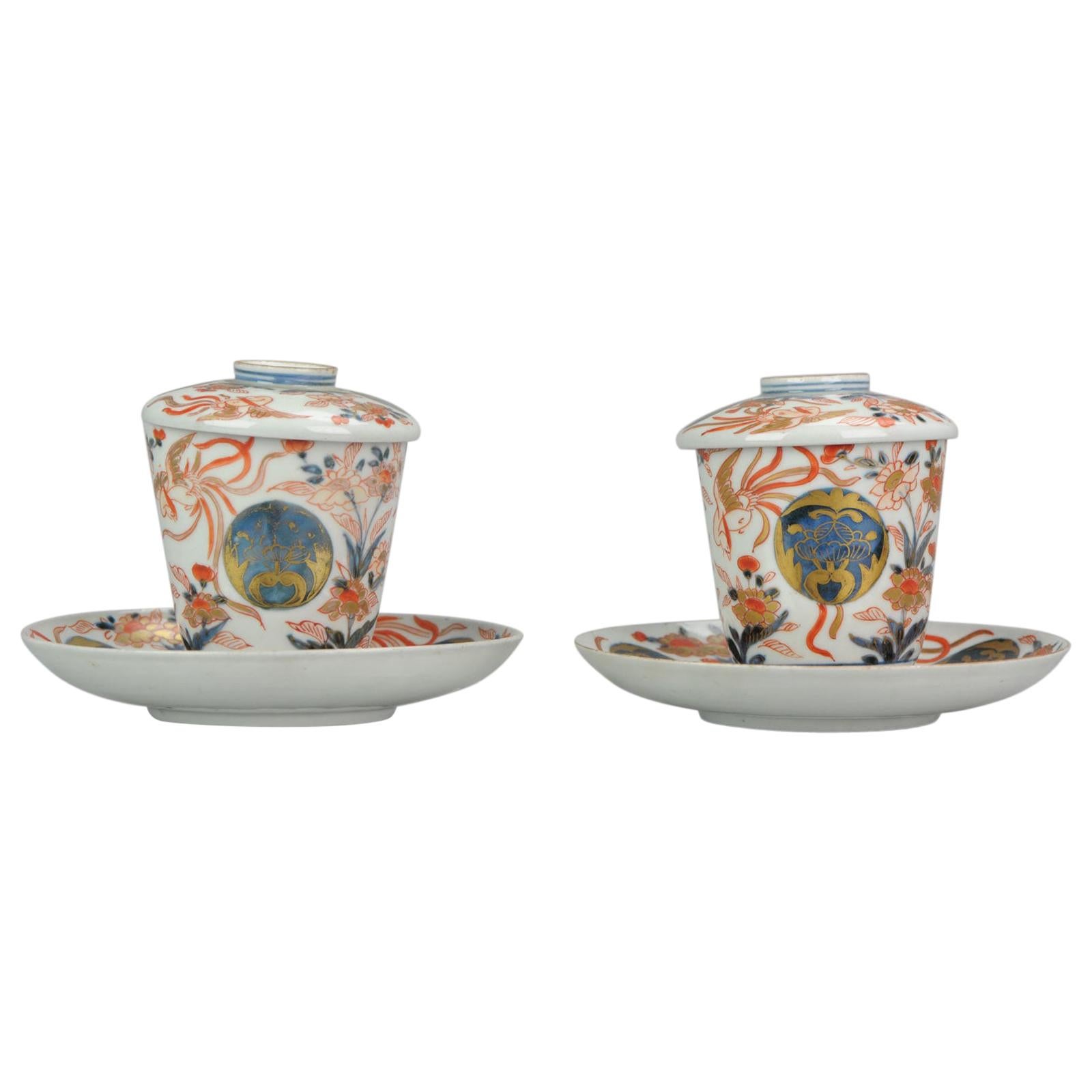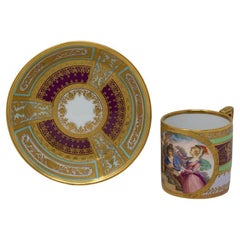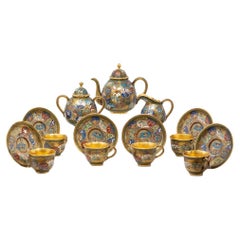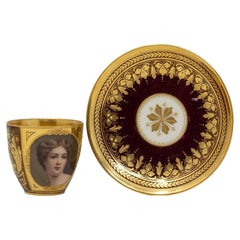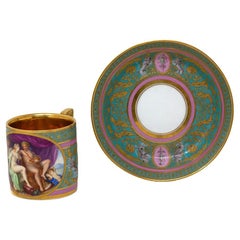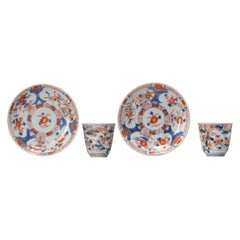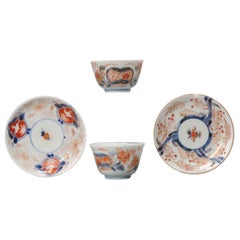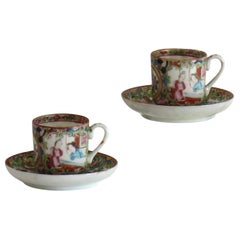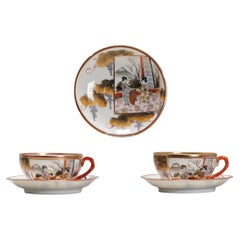Items Similar to Japanese Meiji period (1868-1912) Satsuma Cup and Saucer Pair by Kinkozan
Want more images or videos?
Request additional images or videos from the seller
1 of 20
Japanese Meiji period (1868-1912) Satsuma Cup and Saucer Pair by Kinkozan
$1,319.97
£970
€1,139.59
CA$1,813.42
A$2,024.51
CHF 1,060.81
MX$24,781.96
NOK 13,472.32
SEK 12,702.69
DKK 8,504.87
About the Item
PAIR OF CUP AND SAUCERS BY KINKOZAN
MEASUREMENTS
Saucer 10.8cm Diameter x 1.5cm High (4.25 x 0.6 Inches)
Cup 4.6cm High x 6.7cm Long x 5cm Wide (1.8 x 2.64 x 1.97 Inches)
From our Japanese collection, we are delighted to bring to market this pair of Japanese Satsuma Cup and Saucer Pair by Kinkozan. The pair of Satsuma cup and saucers beautifully decorated with a blue cobalt glaze extensively gilded with a beautiful parallel geometric borders, a central band of flowers and roundels depicting dragons clutching a pearl and butterflies to the centre. The cups with matching decoration to the saucer finished with gilt pin striping to the handle and top rim. The base of each piece is signed by the maker Kinkozan 錦光山 and dates to the late 19th century during the Japanese Meiji period 1868-1912.
KINKOZAN 錦光山
the Kinkozan family have been associated with pottery dating back to 1645. They went on to become the largest producer of Satsuma ware by one individual company, from the end of the 19th century until 1927 after which the factory closed. By the 1850s Kobayashi Sobei (1824-84), Kinkozan Sobei (artist name Kinkozan IV), started to export his products together with the Kyoto manufacturer Taizan VIII. The main target market was America with their main production period approximately between 1875-1927 under the leadership of Kinkozan V(1868-1927).
SATSUMA
ware is a type of earthenware pottery originating from the Satsuma province in Southern Kyushu, Japan’s third largest island.
MEIJI PERIOD
was an era of Japanese history that spanned from 1868 to 1912. It was the first half of the Empire of Japan, when the Japanese people began to build a paradigm of a modern, industrialised nation state and emergent great power, influenced by Western countries and aesthetics. As a result of radically different ideas, the changes to Japan were profound and it affected the social structure, politics, economy, military, and foreign relations across the board. The period corresponded to the reign of Emperor Meiji and was preceded by the Keio era and was succeeded by the Taisho era.
Cultural Art during the Meiji Period was of particular interest to the government and they overhauled the art export market which in turn promoted Japanese arts via various world’s fairs, beginning in Vienna at the world fair in 1873. The government heavily funded the fairs and took an active role organising how Japan’s culture was presented to the world including creating a semi-public company named Kiritsu Kosho Kaisha (First Industrial Manufacturing Company). The Kiritsu Kosho Kaisha was used to promote and commercialise exports of Japanese art and established the Hakurankai Jimukyoku (Exhibition Bureau) to maintain quality standards. For the 1876 Centennial International Exhibition in Philadelphia, the Japanese government created a Centennial Office and sent a special envoy to secure space for the 30,000 items that would be displayed. The Imperial Household also took an active interest in arts and crafts, commissioning works by select artists to be given as gifts for foreign dignitaries further emphasising the high quality and importance of Japanese art. Just before the end of the 19th century in 1890, the Teishitsu Gigeiin (Artist to the Imperial Household) system was created to recognise distinguished artists. These artists were selected for their exceptionally high quality wares and talent in their own industry. Over a period of 54 years Seventy artists were appointed, amongst these were ceramicist Makuzu Kozan and cloisonné enamel artist Namikawa Yasuyuki.
- Creator:Kinkozan (Manufacturer)
- Dimensions:Height: 0.4 in (1 cm)Width: 0.4 in (1 cm)Depth: 0.4 in (1 cm)
- Style:Meiji (Of the Period)
- Materials and Techniques:
- Place of Origin:
- Period:
- Date of Manufacture:Circa 1890
- Condition:Wear consistent with age and use. Minor fading. Very Good, some small areas of rubbing to the gilding.
- Seller Location:Newark, GB
- Reference Number:Seller: HKIRD41stDibs: LU6971243759202
About the Seller
5.0
Gold Seller
Premium sellers maintaining a 4.3+ rating and 24-hour response times
Established in 2019
1stDibs seller since 2022
37 sales on 1stDibs
Typical response time: 3 hours
- ShippingRetrieving quote...Shipping from: Newark, United Kingdom
- Return Policy
Authenticity Guarantee
In the unlikely event there’s an issue with an item’s authenticity, contact us within 1 year for a full refund. DetailsMoney-Back Guarantee
If your item is not as described, is damaged in transit, or does not arrive, contact us within 7 days for a full refund. Details24-Hour Cancellation
You have a 24-hour grace period in which to reconsider your purchase, with no questions asked.Vetted Professional Sellers
Our world-class sellers must adhere to strict standards for service and quality, maintaining the integrity of our listings.Price-Match Guarantee
If you find that a seller listed the same item for a lower price elsewhere, we’ll match it.Trusted Global Delivery
Our best-in-class carrier network provides specialized shipping options worldwide, including custom delivery.More From This Seller
View AllVienna Porcelain Cup and Saucer
By Royal Vienna Porcelain
Located in Newark, England
Decorated with a Female Portrait
Measurements Saucer 2.7cm High x 13.4cm Diameter (1.1 x 5.3 Inches) Cup 6.5cm High x 8.5cm Long x 6.5cm Wide (2.56 x 3.35 x 2.56 Inches)
From our Ceramics collection, we are pleased to offer this Vienna Cup and Saucer. The Vienna Cup and Saucer made from porcelain with a deep dish saucer beautifully decorated with intricate gilt scrollwork bordering each colour and scene. Colours of turquoise and deep purple finish the inner saucer with a central medallion of white glaze. The base of the saucer is signed in underglaze blue with the classic Vienna beehive mark. The matching cup is features a central hand painted romantic scene of a Shepard and shepherdess in a classical garden perched next to a marble bust on column...
Category
Antique Late 19th Century Austrian Ceramics
Materials
Ceramic, Porcelain
Japanese Meiji Period Cloisonne Enamel Tea Set
Located in Newark, England
Extensively Decorated with Traditional Japanese Images
The Tea Set comprises of fifteen pieces including six cup and saucers, a lidded teapot, a lidded sugar pot and a milk jug. The...
Category
Early 20th Century Japanese Meiji Tea Sets
Materials
Metal, Enamel, Metallic Thread
Vienna 19th Century Porcelain Cup and Saucer
By Royal Vienna Porcelain
Located in Newark, England
Decorated with a Female Portrait
From our Ceramics collection, we are pleased to offer this Vienna Cup and Saucer. The Vienna Cup and Saucer with a brown iridescent glaze decorated ...
Category
Antique Late 19th Century Austrian High Victorian Tea Sets
Materials
Ceramic, Porcelain
Antique Vienna Porcelain Cup and Saucer
By Royal Vienna Porcelain
Located in Newark, England
Decorated with a Classical Scene
Measurements Saucer 2.7cm High x 13.4cm Diameter (1.1 x 5.3 Inches) Cup 6.5cm High x 8.5cm Long x 6.5cm Wide (2.56 x 3.35 x 2.56 Inches)
From our C...
Category
Antique Late 19th Century Austrian Belle Époque Ceramics
Materials
Ceramic, Porcelain
French Sevres Château de Fontainebleau Porcelain Serving Dishes
By Manufacture Nationale de Sèvres
Located in Newark, England
Ormolu Mounted
From our Ceramics collection, we are delighted to offer a pair of French Sevres boat-shaped porcelain dishes with original ormolu mounts. The serving dishes beautifully decorated with a frieze of vibrant green undulating foliate garlands interspersed with mosaic style classical romanesque cartouches and birds. The inside decorated with gilt scrollwork embellishments with a six point start to the centre. The porcelain raised on four scrolling legs draped with garlands of fruiting vine. The porcelain bearing the Louis Philippe interlaced L's Sevres mark, the Chateau de Fontainebleau mark, incised marks for the original serves blank manufacturing along with initials and finally the painted initials WB. The dishes dated to the first half of the 19th century 1839/1840 respectively. The ormolu mounts stamped to the base CHER.
Château de Fontainebleau (also known as the Palace of Fontainebleau) is located southeast of Paris and is one of the largest French royal châteaux. The medieval castle served as a residence for the French monarchs from Louis VII...
Category
Antique Mid-19th Century French Louis Philippe Ceramics
Materials
Ormolu
Unusual Pair of Japanese Meiji Period (1868-1912) Satsuma Vases by Kinkozan
By Kinkozan
Located in Newark, England
Taizan Yohei IX Style
From our Japanese collection we are delighted to offer this pair of Japanese Satsuma Vases by Kinkozan. The Satsuma Vases of baluster shape made from earthenwa...
Category
Antique Early 1900s Japanese Meiji Ceramics
Materials
Ceramic, Earthenware, Pottery
You May Also Like
Pair of Arita Edo Period Japanese Porcelain Chocolate Cup / Tea Bowl Japan
Located in Amsterdam, Noord Holland
Very nice edo period examples, 18th century
A Japanese pair of Imari tea bowls / chocolate cups.
Additional information:
Material: Porcelain & Pottery
Type: Tea/Coffee Drinking: Bowls, Cups & Teapots...
Category
Antique 17th Century Japanese Tea Sets
Materials
Porcelain
$558 Sale Price / set
20% Off
Free Shipping
A Set of 2 Japanese Edo Period Gold Imari Porcelain Tea Bowl & Saucer Japan
Located in Amsterdam, Noord Holland
A set of 2 Japanese Edo period Gold Imari Porcelain Tea Bowl & Saucer Japan.
Nice Edo period tea set with imari floral decoration.
Additional informati...
Category
Antique 18th Century Japanese Tea Sets
Materials
Porcelain
$470 Sale Price / set
20% Off
Two PAIRs of Chinese Export Cups and Saucers egg-shell porcelain, Qing 19th C
Located in Lincoln, Lincolnshire
This is Two PAIRS of Chinese export Cups and Saucers made from eggshell porcelain and hand painted in the very decorative Rose Medallion ...
Category
Antique 19th Century Chinese Chinese Export Ceramics
Materials
Porcelain
Antique Japanese Meiji/Showa Period Set of Cups or Tea Bowls Porcelain Eggshell
Located in Amsterdam, Noord Holland
A very nice set of 12 bowls with saucers. Very nicely decorated. They are marked on the base.
Additional information:
Material: Porcelain & Pottery
Region of Origin: Japan
Japan Dyn...
Category
20th Century Japanese Meiji Prints
Materials
Porcelain
$141 Sale Price
20% Off
Pair of Japanese Porcelain Flower Tea Cup Bowl & Saucer Saucer Imari, 18th Cen
Located in Amsterdam, Noord Holland
Porcelain decorated in underglaze cobalt blue. A Mariage
Edo and Qing Dynasty, Kangxi period (1662-1722), c. 1700
Tea Bowl
Additional information:
Material: Porcelain & Pottery
Ty...
Category
Antique 18th Century Japanese Tea Sets
Materials
Porcelain
$318 Sale Price / set
20% Off
Pair of Japanese Porcelain Cup or Chocolate Beaker Saucer Imari Edo Period
Located in Amsterdam, Noord Holland
Lovely and complete pair of sets from the Edo period. Painted with paradise birds and flowers. The enamel and gilt are close to untouched which is really nice, 18th century.
Con...
Category
Antique 17th Century Japanese Edo Ceramics
Materials
Porcelain
$1,132 Sale Price
20% Off
More Ways To Browse
Emperor Japan
Antique Pottery Names
Centennial Furniture
19th Century Cup And Saucer
American Arts And Craft Pottery
Empire Cup
Antique Japanese Cup
Saucers Japan
Japanese Cobalt Blue Ceramics
Cobalt Cup
Empire Vienna
Centennial 1876
Gilded Butterfly
Satsuma Pottery
Japanese Satsuma Pottery
Cobalt Blue Cup
Dragon Pottery
Cup Saucer Japanese
